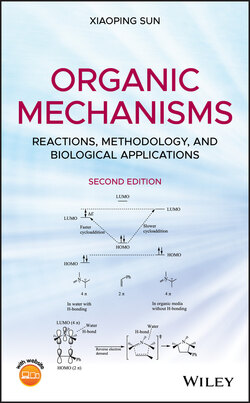Читать книгу Organic Mechanisms - Xiaoping Sun - Страница 26
1.6.2 The Hammond Postulate
ОглавлениеThe exact structure of a transition state is in general not measurable due to its instability. It is in‐between the structures of reactants and products, which can be qualitatively predicted and described by the Hammond postulate [3]. It states that the structure of the transition state for a concerted reaction resembles (closer to) the species (reactant or product) to which it is most similar in energy. According to the Hammond postulate, if a concerted reaction is exergonic (or exothermic if entropy of the reaction ΔS is small and negligible) (Fig. 1.4a), the energy of the transition state is most similar to that of the reactant. Therefore, the structure of the transition state resembles the reactant. Such a transition state is called early transition state. If a concerted reaction is endergonic (or endothermic if entropy of the reaction ΔS is small and negligible) (Fig. 1.4b), the energy of the transition state is most similar to that of the product. Therefore, the structure of the transition state resembles the product. Such a transition state is called late transition state.
Figure 1.5 shows examples of exothermic (ΔH < 0) and endothermic (ΔH > 0) SN2 reactions (concerted). Usually, the entropies of simple SN2 reactions are small relative to the reaction enthalpies, and they are negligible. According to the Hammond postulate, the exothermic SN2 reaction has an early transition state whose structure resembles the reactants (Fig. 1.5a), while the endothermic SN2 reaction has a late transition state whose structure resembles the products (Fig. 1.5b). Although a simple SN2 reaction has a small entropy, the entropy of its transition state (ΔS‡) possesses a relatively large negative value. This is because in the transition state two reactant molecules combine loosely resulting in decrease in entropy. For the exothermic SN2 reaction (Fig. 1.5a), since the reaction has an early transition state which resembles the reactants, both breaking of the old C─I bond and formation of the new C─C bond in the transition state have only proceeded to a small extent. This gives rise to a small ΔΗ‡ value. Therefore, the major contributor to the activation energy is the entropy effect (Ea ≈ −TΔS‡). On the other hand, the endothermic SN2 reaction (Fig. 1.5b) has a late transition state which resembles the products. Breaking of the old C─Cl bond and formation of the new C─I bond in the transition state are close to completion (ΔΗ‡ ≈ ΔH). As a result, both enthalpy (ΔΗ‡) and entropy (ΔS‡) have substantial contributions to the activation energy (Ea = ΔΗ‡ − TΔS‡). Their combination makes the Ea value greater than the reaction enthalpy (ΔH).
FIGURE 1.5 The SN2 reactions that proceed via (a) an early transition state and (b) a late transition state.
